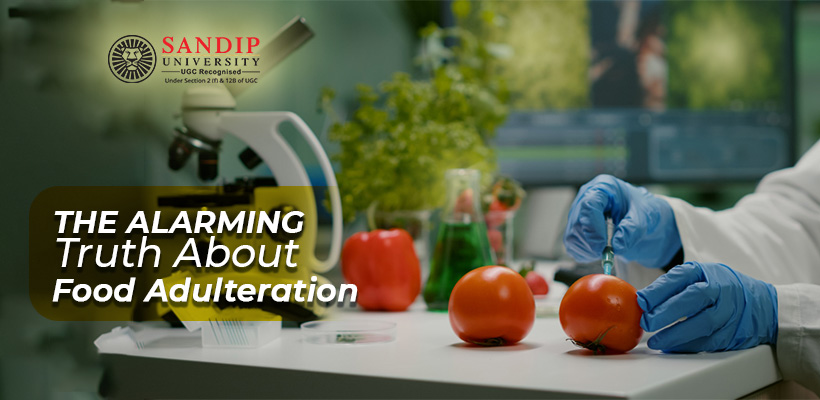Food is the basic need of human beings along with that, it also symbolises culture, enjoyment, and sustenance. On the other hand, to boost profits and prolong shelf life, many producers practice food adulteration which compromise quality. It is just a hidden poison on our plates which affects our health. There are many top pharmaceutical science colleges that are conducting path-breaking research on food adulteration and its impact on our health. Let us take a closer look at the different kinds of food adulteration, and its impact on the human body:
Food Adulteration: What is it and why does it Happen?
Food adulteration is the practice of adding unwanted ingredients to food, for making it look or taste like the original or even better, in order to make money. Adulterants are inferior ingredients added to food for practical and financial reasons, which reduces the food’s nutritional value. Milk, tea/coffee, vegetables, sweets, wheat and other grains, honey, dal, spices, butter and cream, and ice cream are among the common food items that are frequently adulterated in India
Categories of Food Adulteration
- Deliberate Adulteration: Adding adulterants on purpose to increase the weight of the food and increase profits. Mixing chalk dust, sand, stones, etc.
- Inadequate food handling practices can result in unintentional adulteration for example Pesticide residues in cereals.
- Metallic Contamination: Intentional addition of metallic materials, such as iron, mercury and lead.
- Packaging Hazard: Food ingredients may also be disturbed and mixed with packing materials.
Common Adulterants
- Milk: Ingredients such as detergent, starch added to make it thick, water is added to make in large quantities also sometimes artificial milk.
- Spices: Lead chromate, salt powder, combined with turmeric or brick powder combined with chili powder.
- Vegetables: Synthetic dyes like malachite green are used to improve their freshness.
- Tea/Coffee: Iron flakes or coloured leaves can be used to increase its quantity and weight.
- Grains and Legumes: Weight addition by a mixture of stones or artificial materials.
Detect Adulteration using Rapid Test (DART)
Dairy Products
When a milk sample flows smoothly, it is mixed with water because pure milk leaves a white mark. When the milk and water in the container are agitated, a lather forms, which suggests that the milk contains detergent. To perform the starch test, heat the milk product sample with iodine-mixed water until it turns blue, signifying the presence of starch.
Fats and Oils
Put the coconut oil in a glass and let it sit in the refrigerator for half an hour. If it becomes solid it is adulterated and if it remains liquid then not adulterated. Add yellow butter to the oil. The red colour indicates the presence of tri-Ortho-Cresyl-Phosphate.
Sweeteners and Confections
Take 10 ml water and add honey, if dissolve completely it shows presence of sugar
Grains
When food grains are kept in water, if they turn discolored suggest artificially coloured
If the rice is impure, it will turn red when soaked in lime.
Seasoning and Flavouring
Asafetida (hing) burns like camphor when burned in a stainless-steel spoon then it is pure otherwise impure.
Add black pepper to a glass of water; if it floats on water, it means adulterated with papaya seeds.
Take turmeric powder and add to a glass of water, if it exhibits a bright yellow colour, it shows the presence of artificial colour otherwise it shows pale yellow colour.
Fruits and Vegetables
If malachite green is present, a cotton piece soaked in water will turn green when rubbed against the outside of vegetables.
Dip a cotton ball in water and rub it on the outside of the sweet potato. If the cotton becomes coloured, it indicates that rhodamine B, which is used to colour the outside, is present.
Drinks
Combine coffee powder and water, then observe; if the coffee powder contains chicory or clay particles, it will sink to the bottom.
When a magnet is brought close to a small amount of tea leaves on a glass plate, iron filings will show up on the magnet, signifying adulteration.
Advancements in Checking Food Adulteration
- Electronic nose: This device analyses the chemical composition of an odour to find its constituent parts.
- Optoelectronic Sensing: Using the change in refractive index parameter, an AVR microcontroller with an optical sensor, LCD, and keypad can detect milk adulteration with an accuracy of roughly 95%.
- Electronic tongue, a sophisticated combination of chemometrics and infrared spectroscopy, is a cost-effective method for identifying adulterants.
- Biosensors for milk urea detection.
- Detecting very low concentrations of adulteration using Surface Plasmon Resonance (SPR).
What is the Impact of Food Adulteration?
- Chemicals such as artificial colouring, preservatives, and contaminants can cause allergic reactions, digestive problems, organ damage, hormonal imbalances, and possibly chronic diseases.
- Adulteration usually refers to the weakening or substitution of inferior or less costly ingredients for food’s beneficial components. As a result, the nutritional value of the food product significantly declines.
- The presence of dangerous pathogens, contaminants, or elevated levels of toxic substances in food can result from food adulteration. Foodborne illnesses could result from these.
- Food adulteration scandals have the potential to seriously harm the standing of the involved businesses as well as the food industry as a whole.
Conclusion
Food adulteration effects on consumer trust, food quality, and public health. Its effects are minor nutritional deficiencies or major health risks, despite the important roles played by financial incentives and lax regulations. Best pharmaceutical colleges in Maharashtra are finding relevant safeguards against food adulteration. Public awareness, strict law enforcement, DART technologies, are all necessary to find this issue. Ensuring food safety is essential for maintaining the integrity of the entire food system as well as for human health.

